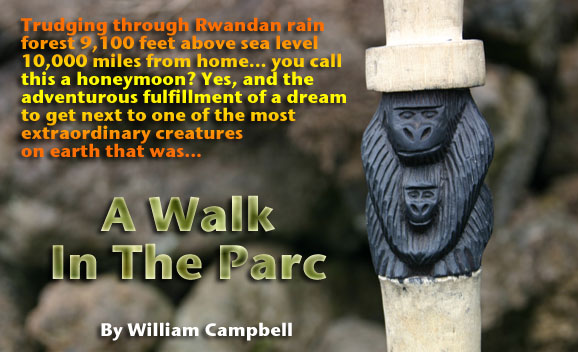
PARC NATIONAL DES VOLCANS, Rwanda — At 8,700 feet and climbing we are on verdant slopes somewhere between a pair of 12,000-foot volcanoes whose distant and still-active tops are shrouded by dense cloud cover.
Ahead of
us, the lead tracker percussively hacks through stands of encroaching
foliage. Halting
to set himself, he raises his machete
above his shoulder and brings it down hard on an ample bamboo stalk
blocking passage along the narrow muddy trail. Slicing cleanly through
its wrist-thick
trunk the blade peals like a bell. This chop-chop-chop… ring!
becomes the rhythm of our demanding trek and we march along with it
hopeful that
each refrain brings us closer to the endangered mountain gorillas that
we have come almost halfway around the world to see in this East-African
country barely bigger than Los Angeles County and less
than half the size of nearby Lake Victoria.
 Entering
Rwanda two days earlier on a one-hour Rwandair flight from Nairobi
to Kigali, my wife Susan
and I are met at the airport by Francis
from Volcanoes Safaris who will be our guide and driver during our stay.
A morning tour around the capital includes an intense and profoundly
sobering visit to the Kigali Memorial Centre, completed in 2004 upon
a site where more than 250,000 victims of the 1994 genocide are interred.
A poolside lunch follows at the tranquil Hotel des Milles Collines — better
known as the Hotel Rwanda from the film of the same name — before
we leave the city via a narrow two-lane highway that we will follow for
our 40-mile journey to the town of Ruhengeri. I can’t say I was
sorry to put Kigali behind us so soon. Perhaps a longer stay would allow
for a better opinion of the place to form, but in terms of a first impression
the one that the people of Kigali made upon us was not all that good.
Many of the looks and attitudes that met us as we moved through its crowded
streets were markedly guarded at best and openly foreboding at their
worst.
Entering
Rwanda two days earlier on a one-hour Rwandair flight from Nairobi
to Kigali, my wife Susan
and I are met at the airport by Francis
from Volcanoes Safaris who will be our guide and driver during our stay.
A morning tour around the capital includes an intense and profoundly
sobering visit to the Kigali Memorial Centre, completed in 2004 upon
a site where more than 250,000 victims of the 1994 genocide are interred.
A poolside lunch follows at the tranquil Hotel des Milles Collines — better
known as the Hotel Rwanda from the film of the same name — before
we leave the city via a narrow two-lane highway that we will follow for
our 40-mile journey to the town of Ruhengeri. I can’t say I was
sorry to put Kigali behind us so soon. Perhaps a longer stay would allow
for a better opinion of the place to form, but in terms of a first impression
the one that the people of Kigali made upon us was not all that good.
Many of the looks and attitudes that met us as we moved through its crowded
streets were markedly guarded at best and openly foreboding at their
worst.
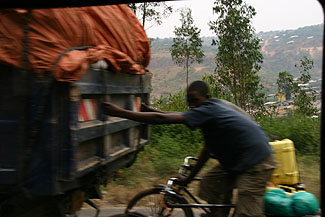 Once outside
the city the scenery becomes almost instantly lush with banana tree
groves everywhere and
a narrow river coursing through the
adjacent farms and criss-crossing the road. Some of the dwellings dotting
the terraced hillsides and highway’s edge are made of brick but
most are mud huts built up with the striking red clay and earth that
covers the countryside. The demeanor from those we pass improves with
the picturesque surroundings as well. Instead of the wariness and resentment
so prevalent in Kigali, we encounter much greater openness and acceptance
found mostly in the beaming faces of children, many who race to greet
us at the roadside upon hearing the Land Rover approaching.
Once outside
the city the scenery becomes almost instantly lush with banana tree
groves everywhere and
a narrow river coursing through the
adjacent farms and criss-crossing the road. Some of the dwellings dotting
the terraced hillsides and highway’s edge are made of brick but
most are mud huts built up with the striking red clay and earth that
covers the countryside. The demeanor from those we pass improves with
the picturesque surroundings as well. Instead of the wariness and resentment
so prevalent in Kigali, we encounter much greater openness and acceptance
found mostly in the beaming faces of children, many who race to greet
us at the roadside upon hearing the Land Rover approaching.
“Mzungu!” they yell and wave.
“What are they saying… mee-zoon-goo?” I ask Francis.
“It means ‘white people,’” he says with a laugh.
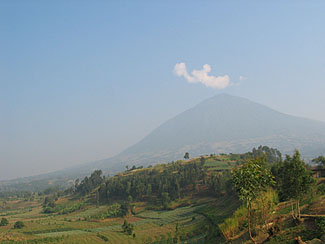 Beyond the
bustle of Ruhengeri our last stretch is a particularly rough climb
up a length of untamed
mountain road until finally we step out
of our vehicle at the entrance of the Virunga Lodge, which opened in
2004. Warmly welcoming us are members of its friendly staff who offer
us cold glasses of freshly squeezed passion fruit juice before showing
us to our rustic and enchanting banda built with the area’s endless
supply of volcanic rock. After settling in we marvel at the astonishing
vistas from our 6,500-foot vantage point. Behind us, rising high above
a patchwork quilt of farms blanketing the hillsides and valleys is the
13,540-foot Muhabura Volcano, and hundreds of feet below the front porch
of our cabin spread lakes Ruhondo and Bulera. With numerous rocky (and
inhabited) islands rising from their surfaces, bathed in the misty late
afternoon sun and backdropped to the horizon by rolling ranges it becomes
clear why this country came to be called Pay des Milles Collines, the
land of a thousand hills.
Beyond the
bustle of Ruhengeri our last stretch is a particularly rough climb
up a length of untamed
mountain road until finally we step out
of our vehicle at the entrance of the Virunga Lodge, which opened in
2004. Warmly welcoming us are members of its friendly staff who offer
us cold glasses of freshly squeezed passion fruit juice before showing
us to our rustic and enchanting banda built with the area’s endless
supply of volcanic rock. After settling in we marvel at the astonishing
vistas from our 6,500-foot vantage point. Behind us, rising high above
a patchwork quilt of farms blanketing the hillsides and valleys is the
13,540-foot Muhabura Volcano, and hundreds of feet below the front porch
of our cabin spread lakes Ruhondo and Bulera. With numerous rocky (and
inhabited) islands rising from their surfaces, bathed in the misty late
afternoon sun and backdropped to the horizon by rolling ranges it becomes
clear why this country came to be called Pay des Milles Collines, the
land of a thousand hills.
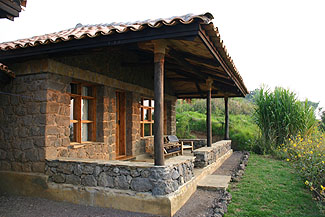 From out
of the darkness at 5 a.m. a wake-up visit by a lodge worker bearing
an oil lantern, coffee,
biscuits and good cheer (no phones or
electricity here) gets us up and on to breakfast and then into the Land
Rover and back down the mountain toward Ruhengeri where even at this
early hour the roadsides are filled with people walking to where they’re
destined to go. At 7 a.m. we arrive at the park’s headquarters,
a small group of tidy buildings near the village of Kinigi. We complete
some additional paperwork and our gorilla trekking permits are verified
to be in order. Susan and I are then attached to what would become a
group of eight tourists and introduced to the two park rangers who would
be leading us into the park and up to the 13 gorillas of Groupe Treize
(whose name and number are purely coincidental).
From out
of the darkness at 5 a.m. a wake-up visit by a lodge worker bearing
an oil lantern, coffee,
biscuits and good cheer (no phones or
electricity here) gets us up and on to breakfast and then into the Land
Rover and back down the mountain toward Ruhengeri where even at this
early hour the roadsides are filled with people walking to where they’re
destined to go. At 7 a.m. we arrive at the park’s headquarters,
a small group of tidy buildings near the village of Kinigi. We complete
some additional paperwork and our gorilla trekking permits are verified
to be in order. Susan and I are then attached to what would become a
group of eight tourists and introduced to the two park rangers who would
be leading us into the park and up to the 13 gorillas of Groupe Treize
(whose name and number are purely coincidental).
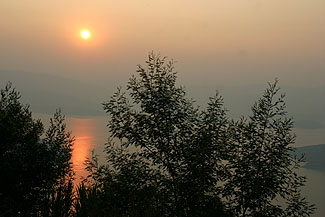 Less
than an hour later we’re back in the vehicle caravaning
with others over rough road that passes through an endless tapestry of
small farms until we arrive at a tiny village where we’re provided
with carved walking sticks and then we set out single-file on foot toward
the volcanoes by first traversing rolling hillsides whose every square
inch is tilled and plowed and otherwise cultivated or planted primarily
with potatoes or pyrethrum flowers (used in the manufacture of Rwanda’s
growing insect repellant industry) almost all the way up to the park’s
distinct boundary marked by a thick and low wall of stacked volcanic
rocks. Crossing into the PNV via a narrow angled passage through the
wall we proceed until we’ve climbed to an elevation of 8,700 feet.
Less
than an hour later we’re back in the vehicle caravaning
with others over rough road that passes through an endless tapestry of
small farms until we arrive at a tiny village where we’re provided
with carved walking sticks and then we set out single-file on foot toward
the volcanoes by first traversing rolling hillsides whose every square
inch is tilled and plowed and otherwise cultivated or planted primarily
with potatoes or pyrethrum flowers (used in the manufacture of Rwanda’s
growing insect repellant industry) almost all the way up to the park’s
distinct boundary marked by a thick and low wall of stacked volcanic
rocks. Crossing into the PNV via a narrow angled passage through the
wall we proceed until we’ve climbed to an elevation of 8,700 feet.
Behind the
chop-chop-chop… ring of the tracker we come to an open
space after trudging up a tiring series of switchbacks through another
hemmed in section of trail, parts of which might provide a test of will
for anyone made anxious by enclosed areas. Not only are some of the narrow
slippery passages through stretches of bamboo thickets and other overgrowth
confining, but visibility is limited. On top of that (and bottom) the
trail is often cross-crossed with what can best be described as trippers
and clotheslines, strong vines that hinder your forward progress. Focus
too much on your feet not getting hung up by the trippers and whack,
a clothesline vine rips the hat from your head. Pay more attention to
the clotheslines and there’s genuinely risk of stumbling into a
pile of month-old forest elephant spore.
Ahead of the tracker and out of view is one of two Rwandan soldiers assigned to accompany us. The other brings up the rear. Each young man is shouldering a well-worn assault rifle for our protection in case of an attack by any of the notoriously bad-tempered Cape buffalo that are at home in the park — or so we’re told by the rangers who serve as our guides pointing out things like the wild celery that mountain gorillas love to eat and a very fresh and large pile of Cape buffalo spore, which we gingerly step around.
Certainly the buffalo are a potential danger, but I suspect our armed escort is also prepared for threats that might arrive on two feet in the form of poachers or rebels. The rangers dismiss that as unlikely and we really have no choice but to believe them. Frankly for Susan and I the allure of coming face to face with one of the most majestic and inspiring creatures on the planet far outweighs any peril involved. With this honeymoon trip almost a year in the planning, we had plenty of time not only to consider the potential dangers of traveling to such a troubled region, but also to envision potentially arduous journeys with hours of risky trekking into the higher altitudes where the gorillas live. Compounding our concern over how taxing the trip might be was the existing degree of uncertainty as to whether or not we’d even get to see the rare and reclusive creatures.
According to the U.S.-based Morris Animal Foundation, there are only about 700 mountain gorillas living in Rwanda and its neighbors the Democratic Republic of the Congo and Uganda. About half live in groups found in the latter country’s Bwindi Impenetrable National Park, and the rest live in the forested Virunga Mountains that straddle the borders those three countries share. On the Rwandan side here within the 81-year-old Parc National des Volcans (PNV) there are seven gorilla groups living within its 50 square miles. Three groups are off limits to tourists, available only to researchers. The other four: Amahoro, Sabyinyo, Susa, and Treize (the latter being the group we are after) are comprised of some 80 gorillas that tourists can visit — but their accessibility is something strictly controlled by the Rwandan government. Gorilla trekking permits, at a cost of $375 per person per day are required in advance, and only 32 are made available on any given date.
Where we’re at, everything — the air, the plants, the ground, our clothes and any exposed skin — is damp. Without warning the outside of my right knee and thigh begins to burn ominously, the telltale sign of contact with a dreaded stinging nettle, which doesn’t let a little thing like long pants stop it from introducing itself.
In another clearing we rest briefly, and the sting of the nettle begins to subside. The sun, looking like a veiled reddish-orange disc breaks through the overcast, but is soon covered back up by the mist and fog that is thick and billowy like smoke. Somewhere in the forest to our right we hear the distinct bird-like calls of some unseen endangered golden monkeys. We are both cold and hot, weary yet anxious to move on, and in short order march back under the thick low canopy of the forest. Two hours in there have been no gorillas in our midst — and at this increasing altitude oxygen is starting to seem elusive, too.
Some distance later the Garmin Forerunner GPS device on my wrist indicates we are closing in on an elevation of 9,100 feet up the ancient alluvial plane that fans down between volcanoes Bisoke on our left and Sabyinyo on our right. My gaze moves up the side of Bisoke until it disappears into the clouds and I wonder how much higher we’ll have to go. I wonder if I’m getting there on a trail Dian Fossey herself used to take.
The sounds of the machete and our footsteps is interrupted by the crackle of the rangers’ radios bringing word from the unseen spotters somewhere up trail, whose job it is to find the gorillas and then relay directions for the rangers to proceed. The news that the gorillas are close is met with a mixture of relief and eagerness.
A few more minutes negotiating the winding trail and we arrive where the trackers have gathered. The gorillas are very close, the rangers tell us and we’re instructed to leave our packs and walking sticks and prepare whatever camera equipment we have. They remind us again to make no sudden movements or loud noises — and no flash photographs. A few hundred more feet up and over the crest of a slight rise and I see my first mountain gorilla. Some 40 feet away down at the bottom of a short slope, almost as if on a stage in front of a bamboo curtain in a natural amphitheater rests a breathtaking 400-pound silverback, the imposing leader of Groupe Treize who is called Agashya. As if on queue, the sun comes out, illuminating the gorgeous sheen of the telltale silvery hair spanning his broad back. Looking imperial, he’s stretched prone on his belly with his massive arms folded in front of him. Back at the park’s headquarters the rangers cautioned that he is known to be somewhat temperamental, but he seems completely at ease with our intrusion. They also told us that with the exception of any infant males, Agashya is the group’s sole male.
And thus, the clock is set ticking and our allotted hour with the mountain gorillas of Groupe Treize has begun. On the face of it, 60 minutes may seem too few, given the expense and the effort. But by its end, the regulated interval is actually more than sufficient, and for the sake of the wholly accommodating gorillas we certainly didn’t want to overstay our welcome and disturb them anymore than we already have.
A few feet to Agashya’s left resides a female less than half his size. She, too, rests belly down on the forest floor with her face low to the blanketing foliage. It takes a few moments to realize that she’s nose-to-nose with an infant cradled complacently in her arms while she meticulously applies some final grooming touches to its tiny face and head.

In just those few moments, the exhaustion of the morning’s long and tall journey is drowned by a surge of invigorated wonder. Coming from a world where such animals as this are presented only in the self-contained environments of zoo exhibits, it is an overwhelming privilege to behold such a scene and there is no benchmark within which to compare the experience of coming into such unprotected contact with these glorious creatures who are not at all put off by our presence.
The rangers let us to move forward getting as close as 25 feet away from the trio and soon the young one has become restless and its mother has allowed it to squirm free of her arms. It sits up seeing us for the first time and moves a few feet closer to us for a better look. Neither its mother nor Agashya show the slightest concern and I’d be lying if I said I didn’t feel honored by — even unworthy of — the trust being shown us strangers.
After a few minutes, the baby comes back to its mother who hauls the little one up onto her back and exits through an opening in the bamboo stalks where we can make out the shapes of several other gorillas relaxing in the shade. We want to follow, but Agashya stays put. And until he moves, we don’t.
At first Agashya appears to have no intention of vacating his place in the sun, but then rises suddenly to a sitting position and there’s a collective gasp of astonishment as he reaches around to scratch his broad back, perhaps assessing us more carefully from this new perspective. We return the favor and find everything about him — his torso, his arms, his hands, his head — immense and powerful.
Finally, as if deciding we’re suitable company and deserve a closer look at the other gorillas of Groupe Treize, he turns and ambles through the bamboo. Following his lead at a respectful distance, we’re awestruck to find ourselves at what amounts to an inner sanctum. To our right about 20 feet away three female gorillas have formed a grooming line with the one seated in front getting her back meticulously administered by the one sitting in the middle who gets cared for by the gorilla bringing up the rear.
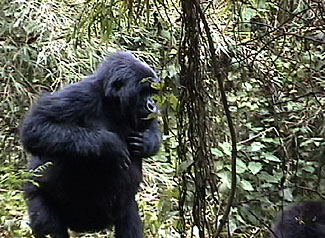 A few feet
beyond them on the left a more rambunctious female decides it’s
high time to climb some of the bamboo and does so until the stalk she’s
on can’t bear her weight and bends downward toward the forest floor until
she hops off and it whips back upright like a catapult. Startled by that a
larger female charges directly toward us with a rapid-fire triple beat to her
chest before veering to her left and careening into the grooming train, sending
those three tumbling and screaming before they scramble up and cavort down
a slope and out of view. The rest in the vicinity follow suit.
A few feet
beyond them on the left a more rambunctious female decides it’s
high time to climb some of the bamboo and does so until the stalk she’s
on can’t bear her weight and bends downward toward the forest floor until
she hops off and it whips back upright like a catapult. Startled by that a
larger female charges directly toward us with a rapid-fire triple beat to her
chest before veering to her left and careening into the grooming train, sending
those three tumbling and screaming before they scramble up and cavort down
a slope and out of view. The rest in the vicinity follow suit.
After a few moments the rangers move us forward down that grade and then up a steep embankment where we’re shortly after treated to Agashya moving to within 15 feet of us to snack on some tasty bamboo shoots. At one point holding a leafy twig in his mouth he looks me right in the eyes, unblinking, until I bow my head in genuine supplication and awe. As if his immediate proximity and acknowledgement weren’t unforgettable enough, a female then enters from our left and parades by at not much more than arm’s length away with her baby looking up inquisitively at us from her back.
As our hour with Groupe Treize draws to its end we emerge to another open area and find Agashya once again prone and relaxed on the forest floor with his females and their young situated around him. As I lie down to get some final photos, a young male barely bigger than Agashya’s head takes issue with me and struts stiff-legged out from behind Agashya onto a flattened section of grass. Positioned between me and his dad he fearlessly surveys me. A moment later he makes a valiant charge and thumps one fist across his chest. I see it for the obvious adorable bluff it is but I also see something familiar in his eyes as he stares into mine, and that I don’t discount.
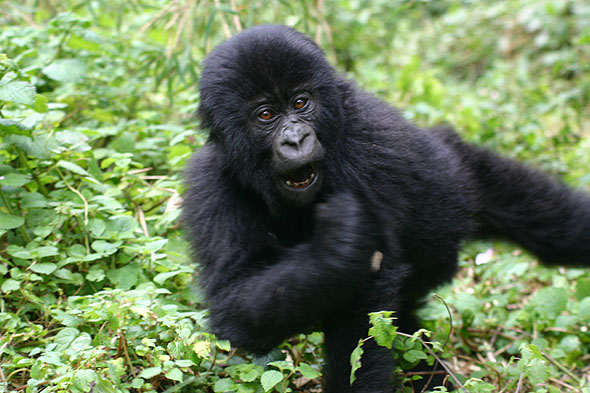
Am I looking at the future leader of Groupe Treize? I bow my head and I hope so.
— • —
William Campbell is a writer living in Silver Lake with his wife Susan. This was their first trip to Rwanda and given the opportunity they wouldn’t hesitate to go back. During the summer of 2006 they stuck much closer to home with a road trip through eight states and even more national parks and monuments. In May of 2007 they will embark on a cruise of the Mediterranean rivieras before ending up in Paris.
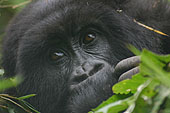
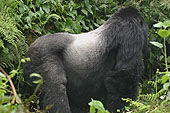
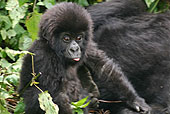




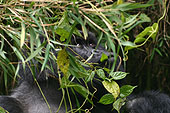
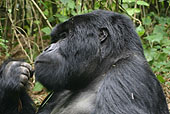

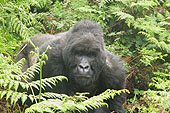
— • —
Regarding Rwanda


General Info:
Rwanda
is only beginning to expand as a tourist destination. Its infrastructure,
accommodations, roads, airways, telecommunications, medical
facilities and availability of consumer goods are basic by western standards.
Tourism:
Americans make up the park’s largest block
of visitors. According to Rwanda tourism statistics for 2004 posted at
PNV headquarters, 1,821 U.S.
citizens trekked after gorillas in 2004 out of a total of 8,593 from all
countries* — an
all-time high (at the low end, Brazilians and Norwegians tied with 12 each).
As Rwanda continues its stabilization supported by the importance of tourist dollars to its economy, the numbers of trekkers have been on the rise in the years following the 1994 genocide when the total worldwide tourists to the park was just 61.
* Source: Office Rwandais de Tourisme et des Parcs Nationaux (ORTPN).
Currency:
Rwandan Franc
Travel Documents:
At the present time only a valid passport
is mandatory for U.S. citizens traveling to Rwanda. A multiple entry
visa recommended
for Kenya.
In order to participate in gorilla treks, permits must be purchased in advance at a cost of $375 per person, per day.
Innoculations:
Yellow Fever
required.
Travel Restrictions:
Presently there are no U.S. State
Department warnings in effect for U.S. citizens traveling to Rwanda.
Weather: Rwanda is near the equator. As a result, the climate does not
change much and the country can be visited throughout the year. The
rainy seasons
tend to be from March–April and October-November, but this varies
in different areas and it can rain any time of the year, especially
in gorilla
trekking areas.
Time:
Rwanda is two hours ahead of Greenwich Mean Time
(10 hours ahead of Los Angeles).
Air Travel:
Regular flights to Kigali
via Rwandair from Nairobi, Kenya.
— • —













